The Elephant in the Room – Transport Energy

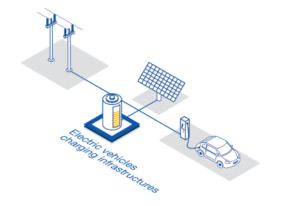
The Elephant in the Room – Transport Energy
There has been many arguments and discussions on the future of our electricity sector and more importantly the state of finances of the CEB, which continues to bleed the national economy. While this does remain a matter of grave concern in need of some rational approach, which is totally lacking looking at the decisions being made on an entirely ad hoc manner. The projections made and the attempts to cover up the most visible uncertainties are hard to believe. However, this lack of objectivity and transparency being clouded over by vague assurances, would requires several pages of text to explore fully. But while this debate would continue and the electricity authorities and their masters, continue to take the country down the drain, the much more dangerous and tragic situation remains completely ignored.
While there is also much debate on the problem of wild elephants, the even wilder elephant in the room remains invisible. That is the tremendous drain on foreign exchange due to the complete dependence on imported fossil fuels for our transport. Sri Lanka spent some 7.5 Billion Dollars for the import of oil back in 2010. But although the import bill in dollar terms came down to Four Billion Dollars by 2020, the rupee equivalent remains at Rs 760 Billion, due to the continued depreciation of the rupee which appears to be inexorable. The trap mankind and Sri Lanka in particular has fallen into, remains just that, a trap, in which we wallow without making any attempt to escape.

The reality, which seems to escape the relevant authorities is illustrated below.
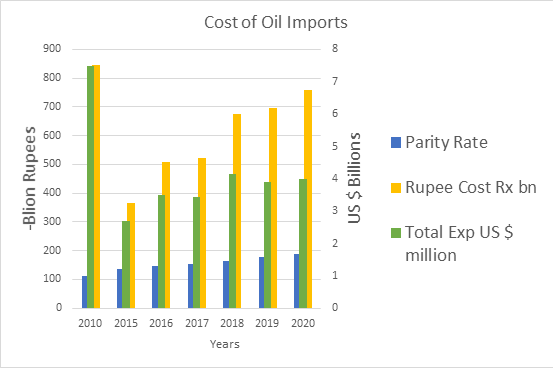
Whereas, electricity which provides only 11% of our primary energy needs, fortunately has some contribution from our own indigenous sources of energy, down to 35% now from a high of 95% in the 1990s. However, the transport sector is 100 % dependent on imported oil. The faint silver lining if I may say so, of the Covid pandemic affecting the whole world, kept the oil prices low and gave some measure of relief to the beleaguered rupee up to now. But looks like the honeymoon is over with the oil prices on an upward trend already past $ 56. Naturally if this trend continues past the $ 60 mark per barrel , then the plans and programs of the central bank to hang on to the dwindling foreign reserves and be able to meet the debt payments , will get completely awry. The highly volatile nature of the world market price of crude oil over which Sri Lanka has absolute no control is shown below.
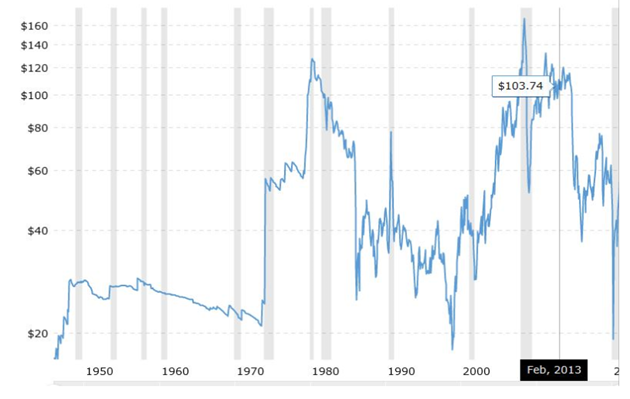
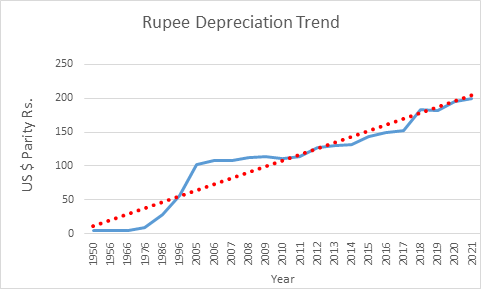
Isn’t it pure insanity to make plans and forecasts for transport , a most important national need based on such a variable and uncontrollable input? This viewed along with the change in parity rate, which with minor fluctuations is on an inexorable upward trend, tells the story.
Fortunately, we are now offered an alternative which was not available even a few years ago.
Are we ready to accept this challenge ?
The wartime Prime Minister of UK, Winston Churchill once said “Never let any Crisis be wasted”. One may add the more familiar saying ”Behind every Crisis lies an Opportunity”. I contributed an article back in March 2020, when the oil prices were quite low, down below $ 30 per barrel, suggesting not to be complacent and make plans for a paradigm shift in the Transport Policy and make use of this opportunity. But surprise surprise no one took any notice.
In contrast the whole world is moving away from the use of petrol and diesel for transport, even General Motors which killed the first Electric Car in the early 1960s , has plans to go all electric by 2025. So have all the major automobile manufacturers and governments with firm plans to totally electrify the transport within this decade itself. The International Energy Agency IEA has predicted that all vehicle manufactured will be electric by the year 2035.
But Sri Lanka in its great wisdom puts up a factory for the manufacture of petrol driven vehicles and brags about it as a great achievement. There are also moves to spend 2.5 Billion dollars to construct a refinery in Hambantota. Also plans are underway to double the capacity of the refinery at Sapugaskanda. These decisions would have been highly appropriate and visionary moves, if taken and implemented at the right time, which was at least a decade ago.
But totally unnoticed to our leaders and their coterie of advisors and experts, the world has changed drastically during this past decade, particularly in the energy sector and the transport vehicle technologies. Due to the great efforts of some committed individuals and private sector companies, the electricity sector still remains to some measure protected from this total dependence. But the transport sector has not moved an inch in the right direction, to ensure protection from the vagaries of the world market prices and deteriorating rupee to buy the dollars needed to pay for the oil.
The overdependence on imported sources of energy in the recent decades, would definitely lead to problems of supplies, even if we have the funds to pay for them. The benefits of any price reductions are now past and the wisdom not to expect such uncertain bonanzas in the future, should dawn on us at least now. In the meanwhile, what is important to the Sri Lankan economy and the consumers is the price per liter in Sri Lanka Rupee terms, which will continue to go up, irrespective of the world market price in US Dollars. The huge import bill on oil itself is largely responsible for the continuing depreciation of the rupee to a very large extent, now exceeding over 6% annually. The recent price hike of the petroleum fuels is therefore not unexpected.
Although the Yahapalana government effectively scuttled the baby steps being taken for the electrification of the light vehicle fleet, the advent of the Covid -19 pandemic has at least led to the wise decision to curtail the import of vehicles, making a virtue of necessity. It is prudent to retain this policy for some years to come. It is recommended that once the import ban is lifted only electric vehicles and perhaps for some year hybrid vehicles should be permitted to be imported with strict controls to limit the imports to the bare necessity.
However, it must be noted that the last energy policy published by the previous government in August 2019, includes a target of reaching 25% electrification of the light vehicles by 2023. A good enough starting point. Who will shake the dust from this policy document and take action for its implementation?
Why Electrify Transport
No doubt Sri Lanka has a back to the wall battle at this point of time, due to the double whammy of increased price of oil and the depleted rupee, to try and reduce the dependence on imported oil, purely on financial considerations at present. But there are very valid scientific, environmental and commercial reasons why electrification of the transport is the wise and obvious way for the future.
As already mentioned all the major automobile manufactures have plans for total departure from the use of Internal Combustion Engines ( ICE) using petrol or diesel in their future vehicles. As such before too long Sri Lanka would have to depend on the laggards who will continue with the ICE engines and face the many problems that would ensue, such as higher costs and lack of spares supply etc.
But the basic thermodynamic reality of the much higher overall efficiency of the conversion of the input energy in the fuel or electricity to useful energy for driving the vehicle itself, is a compelling reasons for this change over, as illustrated below. The reality of gaining from this wonderful boost of efficiency was denied until now till the cost and durability of batteries and the overall cost of the electric vehicles came down to the present values. This change has been rapid and continues on the down ward trend.
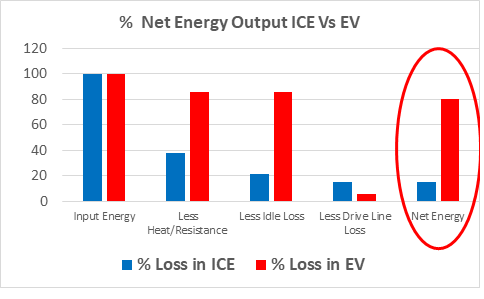
The Way Forward.
The starting point of course is a firm national policy, made mandatory for compliance. Even the institutions under line Ministries often ignore such policies in their day to day programs. Therefore if at this late stage Sri Lanka is to wake up and see a little beyond the collective noses, the following steps are recommended, if Sri Lanka is to covert this Crisis to an Opportunity.
- Declare a policy and time targets to reach 100% electrification of transport sector with intermediate target levels and time frames. Make it a mandatory requirement for all state agencies to abide by and to provide facilitation to achieve same.
- Accept the policy statement “4.5 Enhancing Self Reliance Section 5f” in the National Energy Policy Gazette No 2135/61 of 9th August 2019, as a national target and assign responsibilities of achieving this target to the relevant agencies. CEB/LECO to set up Charging Stations and RMV to limit registration of ICE driven light vehicles
- Remove the punitive duty rates imposed on the import of Electric Vehicles which came in to force on the 1st April 2019. These nearly doubled the price of the EVs coming into the country destroying the small growth seen till then
- Remove the punitive duties and taxes on the import of deep cycle batteries, imposed on the erroneous notion of protecting local battery industry , which does not manufacture any deep cycle batteries, suitable for EVs or for Solar Energy storage
- Levy a charge on all imports of fossil fuels at point of import and use this fund to offset the loss of income to the treasury by action items 3 and 4 above, and to assist the private sector to install charging stations
- Continue the ban on import of vehicles at least for three years more. After that allow only electric vehicles or hybrid vehicles
- Initiate an immediate program to convert existing ICE vehicles to EVs with suitable incentives
The following chart points to the pot of gold at the end of the rainbow.

Most interestingly, a Press Release from the Presidential Office dated 13th June 2021 , makes very interesting reading. It appears that the penny has dropped at last on the sensible actions to be taken in the future. Although some frog in the well type of decisions still remain like assuming that the natural gas costs will remain static or even go down in rupee terms, by and large the proposed actions if carried out holds some hope for the future of Sri Lanka.
If the Government t is to walk the talk, the first action to take while implementing the recommendations above is to cancel any plans to expand the capacity of the Sapugaskanda Refinery using our funds or even loans. If any foreign investors plan to put up any new refineries using their funds without any guarantees of purchase by Sri Lanka, or any other incentives, let that be their look out.
The many ways that this change could benefit the Sri Lankan economy, environment and health is far too many to be included here. But even without such detailed analysis, anyone with common sense can readily understand the timeliness and the value of embarking on this change without any further delay.
I am pleased to end this revised article with a hope of a new dawn.

Eng. Parakrama Jayasinghe
Council member
Bio Energy Association of Sri Lanka
Solar Industries Association of Sri Lanka
Sri Lanka Forum for Sustainable Consumption and Production Forum
E Mail: parajayasinghe@gmail.com

Leave a Reply